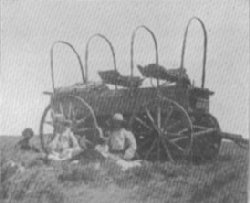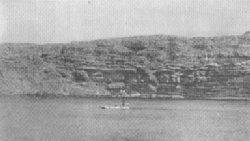Any one who has gone over this country knows too well the stifling heat of these alkali plains. Probably no more desolate place exists than the Colorado Desert on the borders of California and Mexico. And yet such is man's persistence and ingenuity that these arid stretches of waste will soon bloom like oases. Irrigation has come to the rescue. The land in itself was fertile enough, and, in fact, the potentialities of the soil for everything known in agriculture are to-day wonderful. Further, the climate is such that with water, production will be bountiful. And work is going fast apace. Ere long lands that were strewn with the bleaching bones of unfortunate pioneers who were lost in this trackless country, will manifest their richness. Here are mountains of iron, coal and salt,—mines unworked, whose ore would be worth a hundred dollars a ton at the smelter. Soon this is to be productive under the hand of advancing commercialism. The railways have set the pace. With the knowledge that Los Angeles, which, although in blossom itself, is but a short distance from the desert, would profit ere long from the development of this country, railway magnates began pushing southwestward from Salt Lake City. Already the faith in the country has begun to reap rewards. But a short time ago, this natural bride of the Colorado river, this truly rich though seemingly valueless waste. was given the advantages of meager irrigation. The method was simple. Water was taken from the river near the Mexican border by means of a large artificial canal, and conducted through old river beds to the land to be watered. The old river beds needed very little done to them save cleaning of old brush in order to make them the channels of the system. For some 50 miles these river beds are used, and from them extends a system of lateral branches.
The water supply itself when rightly led is everlasting. The Colorado river at its lowest stages carries enough water to irrigate 8,000,000 acres, and of these there are about 3,000,000 acres that can be thus improved simply by the force of gravity. One great engineering feat in connection with this wonderful land reclamation was that of tapping the Colorado. It was necessary to tap this stream so that there would be no danger of flooding the surrounding territory during high water season. This was done by selecting a spot where there was a natural heading in a hill of rock opposite the most powerful current in the river. Strong works of timber and stone were built here taking in the water at a depth of 9 feet below low level. This heading has already withstood heavy pressure successfully. After nine months of careful investigation the Geographical Survey Department of the United States decided upon five irrigation projects which are being developed under the terms of the arid-land reservation act of June, 1902. One of these projects, is the Gunnison tunnel scheme which is expected to reclaim nearly 100,000 acres near Montrose, in Central Colorado. In Nevada it is also proposed to divert water from Lake Tahoe, California, and its outlet, the Truckee river, into the Humboldt Valley, and supply settlers in the vicinity of Reno. Two hundred thousand acres may be reclaimed here. Then there are 500,000 acres along Milk River, in Montana, and 200,000 acres at Tonto Creek, which will be reclaimed. In New Mexico artesian wells are being bored for use as means of irrigation, and great tracts of barren wilderness are being redeemed to the service of agriculture. "UNCLE SAM" AND NUT CULTURE |

